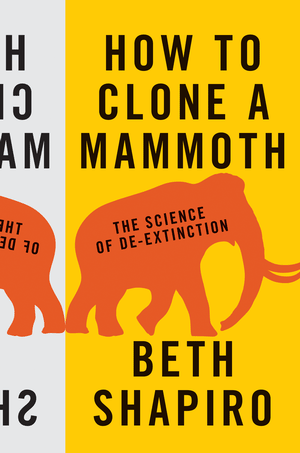These Are the Extinct Animals We Can, and Should, Resurrect
Biologist Beth Shapiro offers a guide to the science and ethics of using DNA for de-extinction
/https://tf-cmsv2-smithsonianmag-media.s3.amazonaws.com/filer/5e/fa/5efacb95-1087-4403-8fa7-927696a46689/4134628044_75cc3b72ef_o.jpg)
Resurrecting extinct animals is both “exhilarating and terrifying,” says Beth Shapiro, an expert in ancient DNA and a biologist at the University of California, Santa Cruz. Exhilarating because of the unprecedented opportunities to understand life and boost conservation efforts, but terrifying in part for its ethical quandaries. In her recent book How to Clone a Mammoth: The Science of De-Extinction, Shapiro builds on her vast experience studying ancient DNA (from woolly mammoths and bison to dodos and passenger pigeons) to offer a primer on the steps required and the questions to answer before species resurrection can become a reality. In a recent interview, we discussed the practicality of de-extinction, and the lighter sides of genetic tinkering.
What extinct animal would you most like to bring back to life?
My answer changes every day. Because there are so many steps along the way to de-extinction, there is no particular species that is an ideal candidate for being brought back to life. The best choice would be an animal that could not only inspire people to be interested in science and technology but that also would have a net positive impact on the environment. In my mind, the mammoth is a great choice for both of these reasons.
Problematically, mammoth de-extinction would necessarily involve working with and manipulating female elephants. We would need elephant eggs, elephant maternal hosts and elephant surrogate families to raise the unextinct mammoths before releasing them into the wild. Before mammoth de-extinction proceeds beyond the first stages of sequencing and manipulating genomes, we need to know much more about how to perform these later steps in ways that are not harmful to elephants.
What extinct animal would be the most fun to bring back?
The dodo. It's very silly looking and has several really weird traits: It can't fly, it retains juvenile characteristics and—obviously—it had no particular fear of humans as predators. If the dodo were to be brought back, it could be restored to protected habitats on [the island nation of] Mauritius, where people could go to observe dodos in their native habitat.
What about the most dangerous?
I would be most afraid of the giant short-faced bear [which lived during the last glacial maximum, until about 11,000 years ago]. When the largest of these bears stood on his hind legs, he would have been nearly 12 feet tall. I wouldn't want to run into him in my backyard.
Not a dinosaur, like a Tyrannosaurus Rex?
It’s not possible. The limit of DNA survival, which we’d need for de-extinction, is probably around one million years or less. Dinosaurs had been gone for a very long time by then.
How long before de-extinction is a reality?
The answer depends on what you're willing to accept as "de-extinction." If you mean a pigeon born with some passenger pigeon traits, or an elephant born with mammoth-like traits, it could happen within a few years to a decade. Longer for mammoths, for the reasons I’ve already mentioned and because elephants have a two-year gestation period. If you mean 100-percent mammoth, with all mammoth genes and behaviors, that will never happen.
What’s the biggest misconception about de-extinction?
The biggest misconception is that we are creating clones. Cloning—the process of somatic cell nuclear transfer, which most famously brought us Dolly the Sheep—is a specific technology that requires cells that are harvested from a living individual. Instead of using this cloning technology, scientists who are working on mammoth de-extinction are using new molecular tools to edit the genomes of elephants so that some of their DNA sequences are changed to look like mammoth DNA sequences.
The result is not a clone but a hybrid: a cell that contains DNA that is mostly elephant, but a little bit mammoth. If that cell is then used to create an embryo and eventually an animal, the result will be a hybrid animal with DNA that is mostly elephant and a little bit mammoth.

Humans have long tinkered with life—what’s the most fascinating example?
Domestication, from dogs and cats to farm animals to the diversity of crop plants that we rely on for food, to bottle gourds that our ancestors domesticated to use as storage containers and floats for fishing boats. Humans have been tinkering with evolution and causing genetic changes for as long as 30,000 years, and we are remarkably good genetic engineers.
What about the most disturbing?
Hairless dogs. Apologies to anyone out there who thinks these creatures are wonderful, and to those who adore them for their anti-allergenic properties. But when I see a hairless dog, all I can think is that I should smear it in sunscreen or wrap it in a blanket.
What endangered animal would you most like to save from extinction?
Black and white rhinoceroses. Don't make me choose between these two. Both are critically endangered, and both could benefit from the same advances in genome engineering that are required to make de-extinction a reality.
At the end of last year, a northern white rhino that lived at the San Diego Zoo died, leaving only five other white rhinos alive [in the world]. Worse, only one of these living northern white rhinos is male, meaning that there is little chance that any more northern white rhinos will ever be born. Even if this male were able to impregnate one of the remaining four females (and this seems unlikely given past failures), the resulting population would have very little genetic diversity. This small population would likely suffer from high levels of inbreeding, which would make it more susceptible to diseases and less able to adapt to a changing climate.
How could de-extinction technology help? If we could sequence the genomes of rhinos that lived in large and genetically diverse populations—rhinos whose bones and skin might be preserved in museum collections, for example—we could identify genetic diversity that has been lost in rhino populations because of the recent declines. Then, we could use genome-editing technologies to re-engineer that lost diversity into living rhino populations.
How will the relationship between humans and nature change in the next century?
As human populations grow, it is more and more of a challenge to find places on our planet that have not been somehow influenced by human activity. If we are going to maintain a rich and biodiverse world, which I believe benefits us as much as the other species who live here, we are going to need to become more active in our approach to conservation. It will not be sufficient to set aside parks or wild spaces.
De-extinction may not be the answer to the biodiversity crisis that we are facing today, but the technologies that are being developed in the name of de-extinction may become powerful new tools in an active conservation regime. Why not provide populations a little bit of genomic assistance so they can survive in a world that is changing too quickly for natural evolutionary processes to keep up?
What do you think Darwin would say about de-extinction?
Upon hearing about de-extinction, he may say, "Why are you bothering with all of these recently extinct things? Let's bring back the ancestral bird that gave rise to of all the Galapagos finches. I have some hypotheses to test."

How to Clone a Mammoth: The Science of De-Extinction